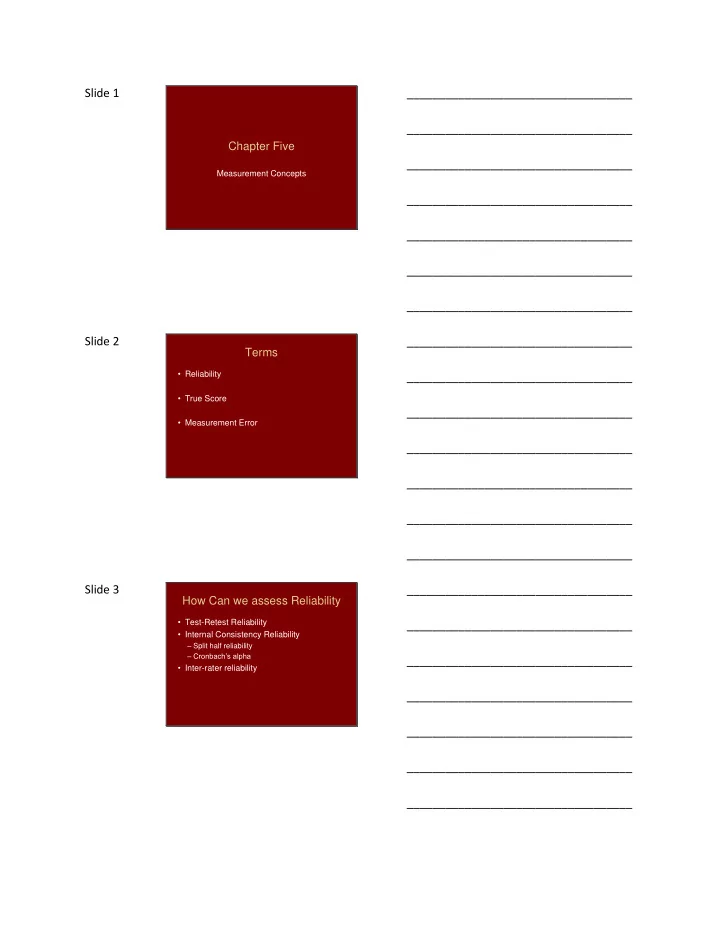

Slide 1 ___________________________________ ___________________________________ Chapter Five ___________________________________ Measurement Concepts ___________________________________ ___________________________________ ___________________________________ ___________________________________ Slide 2 ___________________________________ Terms • Reliability ___________________________________ • True Score ___________________________________ • Measurement Error ___________________________________ ___________________________________ ___________________________________ ___________________________________ Slide 3 ___________________________________ How Can we assess Reliability • Test-Retest Reliability ___________________________________ • Internal Consistency Reliability – Split half reliability – Cronbach’s alpha ___________________________________ • Inter-rater reliability ___________________________________ ___________________________________ ___________________________________ ___________________________________
Slide 4 ___________________________________ Reliability vs. Validity • Reliability-consistency of the measure ___________________________________ • Validity-truth---does the study measure what it says it will measure…is it valid ___________________________________ • ****A measure can be reliable and not valid, but it canno be valid unless it is reliable. ___________________________________ ___________________________________ ___________________________________ ___________________________________ Slide 5 ___________________________________ • Construct validity the adequacy of the ___________________________________ operational definitions of variables • Criterion-Oriented Validity- examining ___________________________________ the relationship between scores on a measure and some criterion. ___________________________________ ___________________________________ ___________________________________ ___________________________________ Slide 6 ___________________________________ Indicators of Validity • Face validity tells whether the measure ___________________________________ appears to measure what it is suppose to.. • Four types of Criterion-related research ___________________________________ approaches ___________________________________ ___________________________________ ___________________________________ ___________________________________
Slide 7 ___________________________________ Types of Criterion-oriented research approaches ___________________________________ • Predictive Validity • Concurrent Validity ___________________________________ • Convergent Validity ___________________________________ • Discriminant Validity ___________________________________ ___________________________________ ___________________________________ Slide 8 ___________________________________ • Predictor Validity- research measuring the extent to which the measure allows you to predict future behaviors. (SAT) • Concurrent Validity -examines the relationship between ___________________________________ the measure and a criterion at the same time. – research whether two or more groups of people differ on a measure in expected ways. • Convergent validity when a measure relates to other scores of the same or similar constructs in a meaningful ___________________________________ and predicted way. – Shy Q scores and Fear of Negative Evaluation Scale • Discriminant validity the measure should discriminate between the construct being measured and other non-related constructs. ___________________________________ – Shy Q and Zuckerman’s Sensation seeking Scale. ___________________________________ ___________________________________ ___________________________________ Slide 9 ___________________________________ Variables & Measurement Scales • Nominal scales have no numerical or quantitative properties, they are naming scales, and their only ___________________________________ property is identity . • Ordinal scales tell us about the relative order of magnitude, but they do not give us info about the ___________________________________ differences b/t categories or ranks. • Interval scale the measurement conveys info about the order and the distance b/t the values • Ratio scales have all the properties of the previous ___________________________________ scales and a true zero point that indicates the absence of the variable being measured ___________________________________ ___________________________________ ___________________________________
Recommend
More recommend